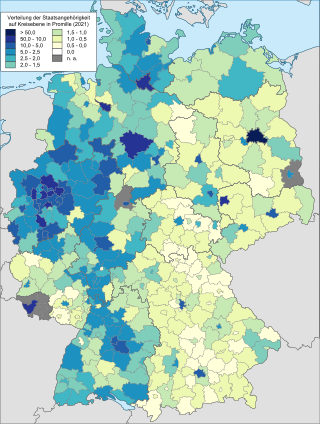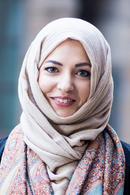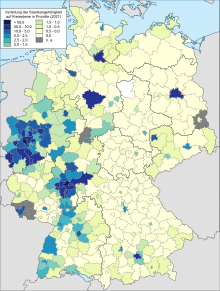
Immigration to Germany, both in the country's modern borders and the many political entities that preceded it, has occurred throughout the country's history. Today, Germany is one of the most popular destinations for immigrants in the world, with well over 1 million people moving there each year since 2013. As of 2019, around 13.7 million people living in Germany, or about 17% of the population, are first-generation immigrants.

Iranians in Germany include immigrants from Iran to Germany as well as their descendants of Iranian heritage or background. Iranians in Germany are referred to by hyphenated terms such as Iranian-Germans or Persian-Germans. Similar terms Iranisch Deutsch and Persisches Deutsch, may be found in Germanophone media. In 2022, Federal Statistical Office of Germany (Destatis) estimates that 304,000 people of Iranian background live in Germany.

Crime in Germany is handled by the German police forces and other agencies.

Syrians in Germany refers to Syrian immigrants in Germany, or Germans with Syrian ancestry. The number of people with an immigration background from Syria, including those with German citizenship, was estimated at around 1,225,000 in 2022. Additionally, the population with Syrian citizenship residing in Germany is 923,000 in 2022, making it the second-largest group of foreign nationals living in the country. Notably, Germany boasts by far the largest Syrian diaspora outside of the Middle East.

Khola Maryam Hübsch is a German journalist and writer of German-Indian origin. Hübsch is the daughter of the German writer Hadayatullah Hübsch. She is a prominent member of the Ahmadiyya Muslim Community of Germany.

During the 2015–2016 celebrations of New Year's Eve in Germany, approximately 1,200 women were reported to have been sexually assaulted, especially in the city of Cologne. In many of the incidents, while these women were in public spaces, they were surrounded and assaulted by large groups of men who were identified by officials as Arab or North African men. The Federal Criminal Police Office confirmed in July 2016 that 1,200 women had been sexually assaulted on that night.

Regine Schumann is a German artist who is classified as a light artist and a contemporary art painter and installation artist.
Crimes may be committed both against and by immigrants in Germany. Crimes involving foreigners have been a longstanding theme in public debates in Germany. In November 2015, a report that was released by the Federal Criminal Police (BKA) stated that "While the number of refugees is rising very dynamically, the development of crime does not increase to the same extent." Interior Minister Thomas de Maizière (CDU) noted that "refugees are on average as little or often delinquent as comparison groups of the local population." A 2018 statistical study by researchers at the University of Magdeburg using 2009-2015 data argued that, where analysis is restricted to crimes involving at least one German victim and one refugee suspect and crimes by immigrants against other immigrants are excluded, there is no relationship between the scale of refugee inflow and the crime rate. In 2018 the interior ministry under Horst Seehofer (CSU) published, for the first time, an analysis of the Federal Police Statistic, which includes all those who came via the asylum system to Germany. The report found that the immigrant group, which makes up about 2% of the overall population, contains 8.5% of all suspects, after violations against Germany's alien law are excluded.

Somalis in Germany are citizens and residents of Germany who are of Somali descent. According to the Federal Statistical Office of Germany, as of 2016, there are a total 33,900 Somalia-born immigrants living in Germany. Of those, 7,985 individuals were granted asylum status.

Jalid Sehouli is a German gynaecologist and oncologist who specializes in peritoneal and ovarian cancer. He is a professor at Berlin's Charité hospital and a writer of scientific as well as fiction works.

Anas Ouahim is a professional footballer who plays as an attacking midfielder for Sheriff Tiraspol on loan from Eerste Divisie club Heracles Almelo. Born in Germany, Ouahim represents Morocco internationally.

Kerstin Griese is a German politician of the Social Democratic Party (SPD) who has been serving as a member of the German Bundestag since 2000.
Michael Maaser is a German historian, archivist of the Goethe University Frankfurt.
Seebrücke is a decentralized, international, civil society movement that was formed in 2018. It is directed against the European policy of isolationism and, in particular, against the criminalization of sea rescue in the Mediterranean. The members show solidarity with all refugees and call on politicians to create safe escape routes.

Germany–Morocco relations date back to the 19th century. The German Foreign Office describes Morocco as a "central partner of the European Union and Germany in North Africa," and Germany is an important trading partner for Morocco. In the past, however, relations have not always been entirely free of tension.

Mithu Melanie Sanyal, also known as Mithu M. Sanyal, is a German academic in cultural studies, a journalist and author. Her main focuses are on feminism, racism, pop culture and postcolonialism.













